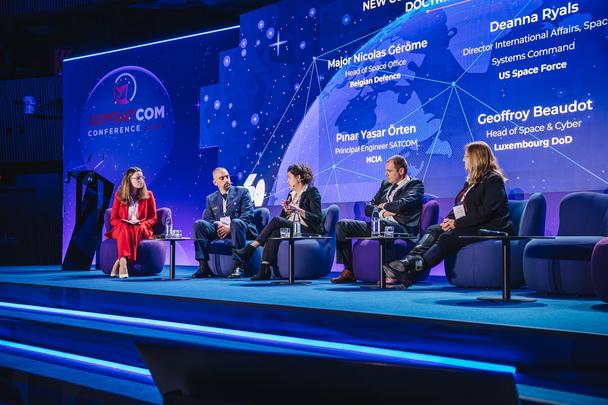GOVSATCOM 2023 Panel - New Constellations and Evolution of Military Doctrine

On February 23rd, Sarah Casenove, Head of Satcom Services Solutions at Airbus, hosted a panel at the annual GOVSATCOM Conference.
Focusing on ‘New constellations and Evolution of Military Doctrine’ the panel shared insight from Major Nicolas Gérôme (Head of Space Office, Belgian Defence), Geoffroy Beaudot (Head of Space & Cyber, Luxembourg DoD), Deanna Ryals (Director International Affairs, Space Systems Command, US Space Force) and Pınar Yasar Örten (Principal Engineer SATCOM, NCIA). The panel offered an expert discussion delving into the future of satcom innovation and the impact on operations moving forward, sharing both industry and military visions.
The importance of satcom in military operations
Satellite communications are an essential component in military operations around the world. Quick and secure information transmission, such as voice and data, is critical to mission success in today’s highly connected and technology-driven battlefield.
Satellites offer a reliable and secure way to do this, providing real-time situational awareness and decision-making capabilities to military leaders, no matter where they are located. They enable the armed forces to have uninterrupted communications across vast distances and in areas where other forms of communication may be limited or non-existent. Furthermore, satellites can support a wide range of military operations, including intelligence gathering, surveillance, reconnaissance, and target acquisition. Supporting strategic and tactical operations, satellite communications are a vital component in modern operational and critical missions. In order to achieve resiliency in the Satcom architecture, capabilities at multiple orbits are required to be performative in operations.
The difference of GEO, MEO and LEO satellites
Non-geostationary satellites orbit (NGSO), For example, Low Earth orbit (LEO) and medium Earth orbit (MEO) satellites, are considered a key component of future satellite communications. Unlike traditional (GEO) geostationary earth orbit, NGSO are much closer to the Earth, providing lower latency and higher data rates.
Geostationary Earth orbit (GEO) satellites are orbiting the furthest from the Earth. This makes them ideal for telecommunications as they require constant coverage of a specific geographic area. Those satellites are used for telecommunications, weather monitoring. They are the backbone of data satellite communications, such as Syracuse IV constellation.
Medium Earth orbit (MEO) satellites have a lower altitude than GEO which allows them to provide coverage over a larger area. They are often favoured due to low latency connection in remote areas. MEO satellites are used for applications such as GPS and mobile satellite services.
Low Earth orbit (LEO) satellites have the most proximity above the Earth's surface. This allows them to provide low latency and high data rates, but with coverage that is limited to specific areas as they move quickly around the Earth. They are most commonly used for satellite imaging, as being near the surface allows them to take images of higher resolution.
NGSO capabilities are an addition, not a replacement. Both are complementary solutions needed to ensure a great resilience into allied operations. In order to be protected by a potential attack, the combination of GEO and NON-GEO satellite availability in operational environments is essential. Hybrid networks combine the strengths of both orbits and mitigates their weaknesses.
The future of satcom with multi-orbit constellations
Governments and international agencies are realising the importance of hybrid connectivity and pushing innovation to the next level.
Using NGSO assets will provide advantages such as increased signal strength and lower latency. However, the panelists all agreed to the reality of using multi-orbit constellations in the future. Integrating these new capabilities requires extensive work and research to provide a seamless experience for end-users. While NGSO satellites have the potential to revolutionize satellite communications, they are just one part of a larger ecosystem that includes traditional geostationary satellites, terrestrial networks, and other emerging technologies.
Reflecting on the panel session, Sarah Casenove says, “The space industry is changing so rapidly – with new technology, constellations and evolving customer requirements driving innovation forward at speed. It’s always great to hear a variety of opinions from key users of Satcom Capabilities; to be a part of that discussion is always a pleasure.
As a Meta Operator within the SatCom market, we at Airbus are constantly striving to provide our user community with the best solution to suit their needs and conduct their operations. With the appearance of NGSO constellations alongside the existing GEO options, we understand that this creates opportunities to develop new user applications and modified use cases and with that, features such as high throughput and low latency are becoming increasingly sought after.
As a Meta Operator, we create hybrid and agnostic solutions led by global mission requirements for our partners, customers and end users”.